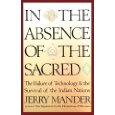Originally published July 29, 2012
In Absence of the Sacred, by Jerry Mander. Readily available for $6.00 – $20.00
I acquired this book at one of those delightful moments provided by a friend of mine. She was attending university at the time and, for my birthday, walked me into the university bookstore and said – pick something, anything. When these rare moments arrive I like to make sure that my selection is not necessarily something I would purchase browsing the shelves with my own budget. I will look for something intriguing, new to me, off my usual radar. I find such treasurers that way!
Written in 1991 the book is an amazing critique of the place technology “owns” in our day to day lives. Mander discusses just how much it permeates our very existence and homogenizes much of humanity into some large mass of consumerism. This is not, however, a book about ditching technology. What Mander does try to do is introduce a bit of thought into the choices we each make whether we, as an individual, are a consumer or a producer of the marvels of our age.
Mander uses the aboriginal societies of a number of continents to show that in the slower paced world, people tend to make decisions based on what the impact will be on future generations. What will be the cost in resources, sustainability, survival and the opportunity for enjoyment of the world around us? He does not, to my recollection, try to say we should ditch all technology. What he does try to say is that more thought should be put into the consequences of our renovations and discoveries before they become common issue and possible problems.
Let’s take a known problem, something that there is not much controversy about: toxic waste. For decades we have fought in court rooms, on barren fields, hospital rooms and community centers to try to get manufacturing and production companies to take more responsibility for the waste they generate. The price in human suffering runs deep before someone, somewhere finally decides enough is enough and then the cost of cleanup, litigation, loss of viability and even livelihoods, becomes such a burden that nearly any advantage gained by the original thought process is destroyed. Yes money is made, perhaps mountains of money. But money is also lost. Companies go bankrupt; people lose jobs, health and life.
Mander proposes that we try a different approach. Instead of dealing with the consequences after the fact; try to anticipate the consequence before hand and weigh the benefits of a particular development or technology against its true costs. Paper diapers are probably a marvelous convenience, but where do they all go when they are used? There are some moves to use our volcanoes as rather efficient garbage dumps, but do we know what the impact of that might really be?
Throughout the book Mander addresses some of the beliefs and customs of various aboriginal peoples around the world. Even pointing out that as efficient and earth friendly as thermal heat may be, in Hawaii it is an offense to the Hawaiian people as an affront to Pele, their primary goddess. The system works well, however, in Iceland. The point is we should be listening to those who have managed to lead sustainable lifestyles for millennium and combine their wisdom with our ever increasing knowledge.
I did not get the impression that Mander wanted us all to return to loin cloths and some mythological pre-industrial Eden. Nor did I get the impression that he was recommending that we should shun advances in medicine, science or technology. What I took away from the book is that as rational beings with the capability of reason, we should take into account the full impact of our activities before we commit to a course of action. Our point of view should be to treasure our resources, to count our home “sacred” in some form or other and to seek sustainability. Avoid becoming an automated consumer, buying whatever is the latest and greatest. Instead, try to build a life around conscientious choices for things which enrich your life; including some of our most advanced technology. Learn to know the difference and choose.




No Comments